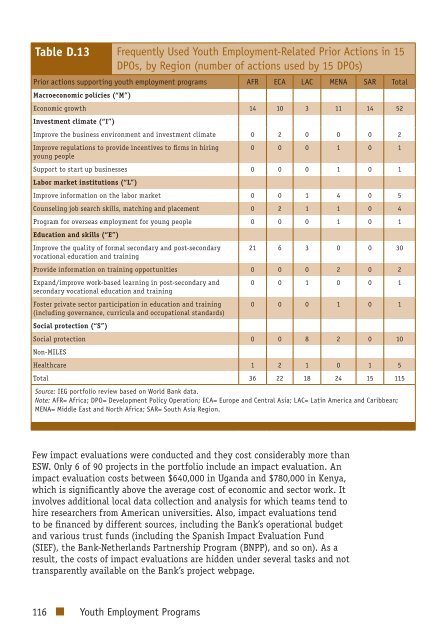Youth Employment Programs - Independent Evaluation Group
Youth Employment Programs - Independent Evaluation Group
Youth Employment Programs - Independent Evaluation Group
You also want an ePaper? Increase the reach of your titles
YUMPU automatically turns print PDFs into web optimized ePapers that Google loves.
Table D.13 Frequently Used <strong>Youth</strong> <strong>Employment</strong>-Related Prior Actions in 15DPOs, by Region (number of actions used by 15 DPOs)Prior actions supporting youth employment programs AFR ECA LAC MENA SAR TotalMacroeconomic policies (“M”)Economic growth 14 10 3 11 14 52Investment climate (“I”)Improve the business environment and investment climate 0 2 0 0 0 2Improve regulations to provide incentives to firms in hiringyoung people0 0 0 1 0 1Support to start up businesses 0 0 0 1 0 1Labor market institutions (“L”)Improve information on the labor market 0 0 1 4 0 5Counseling job search skills, matching and placement 0 2 1 1 0 4Program for overseas employment for young people 0 0 0 1 0 1Education and skills (“E”)Improve the quality of formal secondary and post-secondaryvocational education and training21 6 3 0 0 30Provide information on training opportunities 0 0 0 2 0 2Expand/improve work-based learning in post-secondary andsecondary vocational education and trainingFoster private sector participation in education and training(including governance, curricula and occupational standards)0 0 1 0 0 10 0 0 1 0 1Social protection (“S”)Social protection 0 0 8 2 0 10Non-MILESHealthcare 1 2 1 0 1 5Total 36 22 18 24 15 115Source: IEG portfolio review based on World Bank data.Note: AFR= Africa; DPO= Development Policy Operation; ECA= Europe and Central Asia; LAC= Latin America and Caribbean;MENA= Middle East and North Africa; SAR= South Asia Region.Few impact evaluations were conducted and they cost considerably more thanESW. Only 6 of 90 projects in the portfolio include an impact evaluation. Animpact evaluation costs between $640,000 in Uganda and $780,000 in Kenya,which is significantly above the average cost of economic and sector work. Itinvolves additional local data collection and analysis for which teams tend tohire researchers from American universities. Also, impact evaluations tendto be financed by different sources, including the Bank’s operational budgetand various trust funds (including the Spanish Impact <strong>Evaluation</strong> Fund(SIEF), the Bank-Netherlands Partnership Program (BNPP), and so on). As aresult, the costs of impact evaluations are hidden under several tasks and nottransparently available on the Bank’s project webpage.116 <strong>Youth</strong> <strong>Employment</strong> <strong>Programs</strong>
















